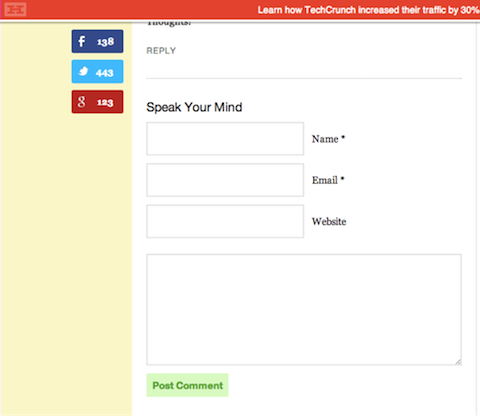
By Neil Patel, from Quick Sprout – http://bit.ly/1iZ6w5T
One of the biggest worries bloggers have is the silent blog syndrome. After putting endless hours of hard work into your blog, you find that it remains silent. No one comments. No one argues. No one praises. It’s a dark and lonely place.
How do you get people to comment on your blog? What tricks, techniques, and powers of persuasion must you possess? A quiet blog can be depressing, while an active blog is exciting. Once people start chiming in, sharing tips, arguing points, and having a conversation, you feel as if your blogging existence has finally been validated.
In this article, I want to explain some of the reasons why people might not be commenting on your blog. And I’m going to tell you what you can do to fix it.
Why no one comments on your blog
Before I dive into the how-to of creating a comment-happy blog, I want to give you some advice on how you should approach the issue.
We often approach the question of gaining comments as if it’s something we can, by trick or by force, get people to do. Actually, it doesn’t work that way. Commenting on a blog is something that your readers do voluntarily.
They choose to do it because they want to. And what prompts their volition? Really outstanding content. It can be outstandingly good. It can be outstandingly bad. It can be outstandingly controversial. It just needs to be outstanding. Create outstanding content before thinking, “How can I get people to comment?”
In addition to that, commenting is really about marketing. If there is no one to read a blog, there will be no comments. If you want blog commenting, you also have to do blog marketing.
Now that we got that out of the way, let’s dive into your blog and figure out why you’re not getting comments.
Do you have a bad comment system?
Let’s start at the ground floor. Can people easily leave a comment? If not, that’s a problem.
I know there are blogs where I would be willing to leave a comment, but I just can’t do it because of a broken comment system. Maybe the Captcha code isn’t working. Or I’m forced to choose an avatar. Or I have to log in to some system. Or I have to wait for the moderator to approve my comment. Or I don’t even know where to click to leave a comment.
All of these factors are comment killers. Look at your blog commenting process with fresh eyes. Or have someone else look at it, navigate it, and try to leave a comment. Fix any barriers and move on.
A good way to ensure that you don’t have these problems is to stick with basic commenting systems. You don’t need to sign up for any crazy commenting systems. Using the default commenting system that comes with WordPress is good enough.
Do you have a poor site design?
If someone doesn’t like your site design, sorry, but they’re not going to leave a comment. I know, it sounds cold and heartless, but design really matters to a potential commenter.
My blog is designed to support interaction. Without even reading an entire article, a user can directly click through to the comments.

Beyond that, I make my comment call to action very simple and straightforward:

When you try to stuff a lot of different elements at the end of a blog, you miss the golden moment for capturing a would-be commenter.
Also, you should show the comments that other people left for the new visitors to see. If you are piping in without knowing what’s already in the queued comments, it’s like saying something in the middle of a conversation that you haven’t even been listening to.
Forbes, for example, does a poor job of encouraging comment interaction because of its busy design and a no-show comment stream:

And for this reason, Forbes doesn’t get a ton of comments per post.
Your site design needs to help encourage comments. A well-designed blog is the starting point for anything good in life, comments included.
Do you blog as a corporate entity?
One of the hardest things to do is to blog as the voice of a business. Does a business write? Does a business speak? Does a business blog?
It’s a pretty awkward way to write. And it’s painfully boring to read.
The best blogs are those that come from a person, an individual…someone with a voice, emotion, feeling, passion, and experiences.
You probably recognize blogs from people like Seth Godin, Perez Hilton, and Tim Ferris. Why? Because these blogs are hot! They’re comment-heavy. They’re popular. And, get this: they’re personal.
Even if the content isn’t written exclusively by the personality backing the blog, you know that the content is going to have a very personal flavor. You don’t have to be a celebrity to create content like this. You just need to be yourself.
People will comment and interact with other people, not with a faceless and soulless corporate mouthpiece. Be personal, and the comments will come.
Do you say anything original?
“Being original” is really hard. You might whine and think that originality is impossible. But when you read about Nikola Tesla, Thomas Edison, Elon Musk, or Jackson Pollock, you’d eat your words about originality.
You can be original. But, like I said, it’s really hard.
As hard as it may be, strive for originality on your blog. Or, if you can’t be 100% original, steal the best ideas from the brightest people, and put your spin on it. Say something unoriginal in an original way.
Do you have a boring writing style?
Great content gets shared and commented on. Boring content gets ignored.
If you’re struggling with a no-comment blog, you may want to explore ways of getting more interesting. Too many passive sentences? No strong verbs? Lack of anecdotes? Dry topics?
Figure it out, and rework your content to make it a bit more exciting. In other words, spice up your writing style. Be personal, clear, and concise.
Do you ignore interaction?
When you write a blog post, you’re starting a conversation. And, if you start a conversation, you should do the polite thing and continue that conversation.
If someone comments on your blog, do your best to respond to it. You don’t have to write a long personal letter to everyone, but at least acknowledge their presence. They’ve done you a favor, so return it.
When you, as the author of a blog, ignore interaction, it discourages any further interaction. I do my best to jot a quick reply to every commenter. I can’t provide answers to all the questions or address every issue. I do, however, want to respond with courtesy and respect to every person who has taken the time to read and respond to my content.
Do you ask for comments?
There’s no shame in asking for comments. Just ask for them.
If you remember only one point from this article, this is the one: To get comments, ask for them.
It’s not begging. It’s not groveling. It’s not whining. It’s a polite invitation to have a civil discussion about an important issue.
Here are some of the angles you can use to encourage participation:
- Ask a leading question – I usually raise a question at the end of each article, just to get people thinking. Sometimes, these questions surface in the comments.
- Raise an issue for discussion – rather than have a maybe-approach to comments, go ahead and start the discussion yourself. Tell people what to talk about.
- Tell your readers their input is valuable – your readers want to know that they have a voice too. Although you’re providing information, you welcome their perspectives and insights. Tell them so. “I’d love to hear what you think about this issue. Let me know in the comments.”
When asking for comments, keep in mind that requests like “please comment!” are weak and uninspiring. Try to be a bit smoother and more engaging:
- “I’m wondering what other people think about the new widget. Tell me about your experience in the comments below.”
- “I’m probably leaving out some information. What other tips can you provide about this issue?”
- “Share your story in the comments.”
Do you provide something of value in your writing?
When people read your content, they’re basically giving you their money. As you already know, time is money. If readers spend their time/money on your content, they expect to derive some value. Is your content valuable? Is it worth your readers’ time/money?
If it is, they might voice this in the comments. If you’re not providing something of value, people will feel slightly ripped off. They spent this time reading your article but got nothing good from it.
The more value you provide in your content, the better comment interaction you’re going to score. Think of your readers as customers dropping a few dollars in order to read your blog post. What are you going to give them in return?
Do you write anything really compelling?
You’ve probably been to an epic concert, performance, speech, or movie at the end of which you just wanted to stand up and let out a shout of appreciation.
You can create content that evokes similarly strong emotions and reactions. People want to be motivated, encouraged, or challenged. If you write in a way that moves people, they will likely be moved to leave a comment.
It goes back to the issue I keep harping on — it’s all about the content.
Do you ever get controversial?
Sometimes, you just need to say what you think and let the chips fall where they may. Strong people are not afraid to be opinionated, and they have the thick skin to take the kickback. If you have a personal blog, you have the right to voice your concerns, raise questions, or confront people.
The more open you are, the more likely people are to respond with comments.
A blog is like any form of human communication. It’s a two-way street. But in order for the listener to respond, he or she must feel like there’s something to respond to. If you dip your toe in the waters of controversy, you can be pretty sure someone is going to respond.
If you feel strongly about a relevant trend, current issue, or hot topic, go ahead and write freely. Even if it’s a tad on the controversial side.
Conclusion
There are so many advantages to an active blog. You generate excitement, get engagement, elicit feedback, establish authority, invite backlinks, and get extra SEO juice.
It’s a beautiful thing. All you have to do is get rid of the barriers to comments and produce the best content you possibly can.
What else can you do to invite comments on your blog?
